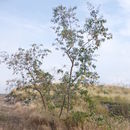en
names in breadcrumbs


Nicotiana glauca,commonly referred to as wild tobacco or tree tabacco, can be described as a small shrub that stands about 5 m tall (Furer, Hersch, Silvetzki, Breuer, Zevin, 2011; 47). The leaves ofN. glaucaare large, alternate, ovate, and colored blue-green (Furer, Hersch, Silvetzki, Breuer & Zevin, 2011; 47). The shrub gets its name from the color of its leaves, stemming from the Greek wordglaucameaning bluish-gray (Furer, Hersch, Silvetzki, Breuer & Zevin, 2011; 47). Nicotiana glauca, tree tobacco, is a flowering plant belonging to the potato family (Natureserve 2014). The flowers are tubular and yellow with lengths ranging from 32 to 42 mm (Ollerton, Watts, Connerty, Lock, Wilson, Schueller, Nattero, Cocucci, Izhaki, Geerts, Pauw & Stout, 2012: 88).
Nicotinana glauca is native to South America in Bolivia and Argentina (Tadmor-Melamed, Markman, Arieli, Distl, Wink & Izhaki 2004: 845). It is not native to the United States but has found to be an invasive species in Alabama, Arizona, California, Florida, Hawaii, Maryland, New Jersey, New Mexico, and Nevada (NatureServe, 2014). Nicotiana glauca has also been found in Peru, Israel, Tenerife, Greece, South Africa, and Australia (Ollerton, Watts, Connerty, Lock, Wilson, Schueller, Nattero, Cocucci, Izhaki, Geerts, Pauw & Stout, 2012: 87).
It mainly thrives in dry semi-arid locations such as quarries, dry riverbanks and along roadsides (Ollerton, Watts, Connerty, Lock, Wilson, Schueller, Nattero, Cocucci, Izhaki, Geerts, Pauw & Stout, 2012: 86-87). In South Africa and South America, the plant is seen growing alongside roads, in cattle fields, and is a common weed along rivers (Botha, Steenkamp, Oliver & Bekker, 2011: 2). N. glaucais a wide spread plant that can be found growing in warm dry climates with low elevation (Plumlee, Holstege, Blanchard, Fiser & Galey, 1993: 498).
The high amount of nectar found in Nicotiana glauca attracts pollinators and nectar robbers. Mean nectar concentration can be from 20-44% (Ollerton, Watts, Connerty, Lock, Wilson, Schueller, Nattero, Cocucci, Izhaki, Geerts, Pauw & Stout, 2012: 92). In South America the hummingbird Chlorostilbom aureoventri is can be both a pollinator and nectar robber (Ollerton, Watts, Connerty, Lock, Wilson, Schueller, Nattero, Cocucci, Izhaki, Geerts, Pauw & Stout, 2012: 89). In South Africa three species of sunbirds act as pollinators the Makachite Sunbird (Nectarina famosa), the Dusky Sunbird (Cinnyrus fuscus), and the Southern Double Colored Sunbird (Cinnyrus Chalybea) (Ollerton, Watts, Connerty, Lock, Wilson, Schueller, Nattero, Cocucci, Izhaki, Geerts, Pauw & Stout, 2012: 89). In introduced areas where no birds are present, self pollinations have occurred prior to larger populations of Nicotiana glauca that attract birds to the area (Ollerton, Watts, Connerty, Lock, Wilson, Schueller, Nattero, Cocucci, Izhaki, Geerts, Pauw & Stout, 2012: 92).
Mean population fruit set per plant of Nicotiana glauca ranges from about 28% to 75% (Ollerton,J., Watts, S., Connerty, S., Lock, J., Wilson, I., Schueller, S., Nattero, J., Cocucci, A. A., Izhaki, I., Geerts, S., Pauw, A., Stout, J.C. 2012: 86). The seed viability of 86-93% may be correlated with plant density (Ollerton, Watts, Connerty, Lock, Wilson, Schueller, Nattero, Cocucci, Izhaki, Geerts, Pauw & Stout, 2012: 87 and 89).
Nicotiana glaucais characterized by the presence of pyridine alkaloids in the leaves and root tissues of the plant.N. glaucacontains anabasine and nicotine, which can be deadly if ingested in large amounts (Botha, Steenkamp, Oliver, Bekker, 2011; 116). In a study of Palastine sunbirds (Nectarinia osea) it was found that the birds were deterred by nicotine concentrations of (0-5ppm) and anabasine (5 ppm) found in the plant (Tadmor-Melamed, Markman, Arieli, Distl, Wink & Izhaki 2004: 848). Birds did not consume high alkaloid concentrations if present in concentrations of 77-88% but tolerated low concentrations (Tadmor-Melamed, Markman, Arieli, Distl, Wink & Izhaki 2004: 847).
Although both anabasine and nicotine are dangerous, the main cause of death due to the ingestion ofN. glaucais caused by the alkaloid anabasine (Furer, Hersch, Silvetzki, Breuer, & Zevin, 2011; 48). Anabasine causes a greater depression of respiration and blood pressure than that of the ingestion of nicotine (Plumlee, Holstege, Blanchard, Fiser & Galey, 1993: 499).In roughly 15 minutes after the ingestion of Anabasine, signs of the toxin begin to appear and the animal infected starts to experience weakness, ataxia, tremors, and collapse (Plumlee, Holstege, Blanchard, Fiser & Galey, 1993: 499).Anabasine binds to nicotonic binding sites and inhibits acetylcholinesterase (Plumlee, Holstege, Blanchard, Fiser & Galey, 1993: 499).This happens at the neuromuscular junction and autonomic ganglia within the brain causing a blockade (Furer, Hersch, Silvetzki, Breuer, & Zevin, 48). This neuromuscular blockade prohibits respiratory signals to be sent to the brain, thus causing a prolonged blocking (Furer, Hersch, Silvetzki, Breuer, & Zevin, 2011: 48). This prolonged blocking causes a strong stimulation of the Central Nervous System and thisstimulationcauses total paralysis of skeletal muscles and directly contributes to the tremors and convulsions seen in most cases of anabasine poisoning (Furer, Hersch, Silvetzki, Breuer, & Zevin; 49). The cause of death is respiratory paralysis (Botha, Steenkamp, Oliver & Bekker, 2011: 116).
Anabasine toxicosis has been reported in humans, pigs, cattle, sheep, and goats (Plumlee, Holstege, Blanchard, Fiser & Galey, 1993: 499). Anabasine can not only be fatal but can effect development of animals within the womb (Plumlee, Holstege, Blanchard, Fiser & Galey, 1993: 499).One case of anabasine poisoning was seen in a flock of Ostriches in South Africa (Botha, Steenkamp, Oliver & Bekker, 2011: 1). The Ostriches started experiencing muscle weakness to a point where they couldn’t stand up nor hold their head up right (Botha, Steenkamp, Oliver & Bekker, 2011: 116). They began to have body tremors and involuntary muscle spasms followed by respiratory failure (Botha, Steenkamp, Oliver & Bekker, 2011: 116).
Some people use this plant as ornamental purposes in their gardens (Botha, Steenkamp, Oliver & Bekker, 2011: 116). Navajo Indians smoked this plant for ritual purposes and in places like Arizona, California, Texas, Mexico, Hawaiian Islands, Australia, and in the Mediterranean,N. glaucais also smoked (Furer, Hersch, Silvetzki, Breuer & Zevin, 2011: 47).